DeWalt DW907 Handleiding
DeWalt
Boormachine
DW907
Bekijk gratis de handleiding van DeWalt DW907 (7 pagina’s), behorend tot de categorie Boormachine. Deze gids werd als nuttig beoordeeld door 105 mensen en kreeg gemiddeld 4.3 sterren uit 53 reviews. Heb je een vraag over DeWalt DW907 of wil je andere gebruikers van dit product iets vragen? Stel een vraag
Pagina 1/7

INSTRUCTION MANUAL
GUIDE D'UTILISATION
MANUAL DE INSTRUCCIONES
DC750, DC740, DW907, DW926
Cordless Adjustable Clutch Driver/Drill
Perceuse-tournevis sans fil à embrayage réglable
Taladro/Destornillador Inalámbrico con Embrague Ajustable
INSTRUCTIVO DE OPERACIÓN, CENTROS DE SERVICIO Y PÓLIZA
DE GARANTÍA. ADVERTENCIA: LÉASE ESTE INSTRUCTIVO
ANTES DE USAR EL PRODUCTO.
IF YOU HAVE ANY QUESTIONS OR COMMENTS ABOUT THIS OR ANY DEWALT TOOL,
CALL US TOLL FREE AT: 1-800-4-DEWALT (1-800-433-9258)
General Safety Rules – For All Battery Operated Tools
WARNING! Read and understand all instructions. Failure to follow all instructions listed
below may result in electric shock, fire and/or serious personal injury.
SAVE THESE INSTRUCTIONS
WORK AREA
•
Keep your work area clean and well lit. Cluttered benches and dark areas invite accidents.
•
Do not operate power tools in explosive atmospheres, such as in the presence of flam-
mable liquids, gases, or dust. Power tools create sparks which may ignite the dust or
fumes.
•
Keep bystanders, children, and visitors away while operating a power tool. Distractions
can cause you to lose control.
ELECTRICAL SAFETY
•
Do not abuse the cord. Never use the cord to carry the tool. Keep cord away from heat,
oil, sharp edges or moving parts. Replace damaged cords immediately. Damaged cords
may create a fire.
•
A battery operated tool with integral batteries or a separate battery pack must be
recharged only with the specified charger for the battery. A charger that may be suitable
for one type of battery may create a risk of fire when used with another battery.
•
Use battery operated tool only with the specifically designated battery pack. Use of any
other batteries may create a risk of fire.
PERSONAL SAFETY
•
Stay alert, watch what you are doing and use common sense when operating a power
tool. Do not use tool while tired or under the influence of drugs, alcohol, or medication. A
moment of inattention while operating power tools may result in serious personal injury,
•
Dress properly. Do not wear loose clothing or jewelry. Contain long hair. Keep your hair,
clothing, and gloves away from moving parts. Loose clothing, jewelry, or long hair can be
caught in moving parts. Air vents often cover moving parts and should also be avoided.
•Avoid accidental starting. Be sure switch is in the locked or off position before inserting bat-
tery pack. Carrying tools with your finger on the switch or inserting the battery pack into a tool
with the switch on invites accidents.
•
Remove adjusting keys or wrenches before turning the tool on. A wrench or a key that
is left attached to a rotating part of the tool may result in personal injury.
•
Do not overreach. Keep proper footing and balance at all times. Proper footing and balance
enables better control of the tool in unexpected situations.
•
Use safety equipment. Always wear eye protection. Dust mask, non-skid safety shoes,
hard hat, or hearing protection must be used for appropriate conditions.
TOOL USE AND CARE
•
Use clamps or other practical way to secure and support the workpiece to a stable
platform. Holding the work by hand or against your body is unstable and may lead to a loss
of control.
•
Do not force tool. Use the correct tool for your application. The correct tool will do the
job better and safer at the rate for which it is designed.
•
Do not use tool if switch does not turn it on or off. A tool that cannot be controlled with
the switch is dangerous and must be repaired.
•
Disconnect battery pack from tool or place the switch in the locked or off position
before making any adjustments, changing accessories, or storing the tool. Such pre-
ventative safety measures reduce the risk of starting the tool accidentally.
•
Store idle tools out of reach of children and other untrained persons. Tools are dan-
gerous in the hands of untrained users.
•
When battery pack is not in use, keep it away from other metal objects like: paper
clips, coins, keys, nails, screws, or other small metal objects that can make a con-
nection from one terminal to another. Shorting the battery terminals together may cause
sparks, burns, or a fire.
•
Maintain tools with care. Keep cutting tools sharp and clean. Properly maintained tools,
with sharp cutting edges are less likely to bind and are easier to control.
•
Check for misalignment or binding of moving parts, breakage of parts, and any other
condition that may affect the tools operation. If damaged, have the tool serviced before
using. Many accidents are caused by poorly maintained tools.
•
Use only accessories that are recommended by the manufacturer for your model.
Accessories that may be suitable for one tool, may create a risk of injury when used on
another tool.
SERVICE
•
Tool service must be performed only by qualified repair personnel. Service or mainte-
nance performed by unqualified personnel result in a risk of injury.
•
When servicing a tool, use only identical replacement parts. Follow instructions in the
Maintenance section of this manual. Use of unauthorized parts or failure to follow
Maintenance Instructions may create a risk of shock or injury.
Additional Safety Rules
•
Hold tool by insulated gripping surfaces when performing an operation where the tool
may contact hidden wiring. Contact with a “live” wire will also make exposed metal parts of
the tool “live” and shock the operator.
WARNING: ALWAYS use safety glasses. Everyday eyeglasses are NOT safety glasses.
Also use face or dust mask if cutting operation is dusty. ALWAYS WEAR CERTIFIED SAFETY
EQUIPMENT:
• ANSI Z87.1 eye protection (CAN/CSA Z94.3)
• ANSI S12.6 (S3.19) hearing protection
• NIOSH/OSHA/MSHA respiratory protection.
WARNING: Some dust created by power sanding, sawing, grinding, drilling, and other
construction activities contains chemicals known to cause cancer, birth defects or other
reproductive harm. Some examples of these chemicals are:
• lead from lead-based paints,
• crystalline silica from bricks and cement and other masonry products, and
• arsenic and chromium from chemically-treated lumber (CCA).
Your risk from these exposures varies, depending on how often you do this type of work. To
reduce your exposure to these chemicals: work in a well ventilated area, and work with
approved safety equipment, such as those dust masks that are specially designed to filter out
microscopic particles.
•Avoid prolonged contact with dust from power sanding, sawing, grinding, drilling,
and other construction activities. Wear protective clothing and wash exposed areas
with soap and water. Allowing dust to get into your mouth, eyes, or lay on the skin may
promote absorption of harmful chemicals.
WARNING: Use of this tool can generate and/or disburse dust, which may cause serious and
permanent respiratory or other injury. Always use NIOSH/OSHA approved respiratory protection
appropriate for the dust exposure. Direct particles away from face and body.
CAUTION: Wear appropriate personal hearing protection during use. Under some con-
ditions and duration of use, noise from this product may contribute to hearing loss.
CAUTION: When not in use, place tool on its side on a stable surface where it will not
cause a tripping or falling hazard. Some tools with large battery packs will stand upright on
the battery pack but may be easily knocked over.
• The label on your tool may include the following symbols. The symbols and their definitions
are as follows:
V..................volts A ....................amperes
Hz................hertz W ....................watts
min ..............minutes ..................alternating current
............direct current no....................no load speed
................Class I Construction ....................earthing terminal
....................(grounded) ....................safety alert symbol
................Class II Construction .../min..............revolutions per minute
....................(double insulated) BPM................beats per minute
SAVE THESE INSTRUCTIONS
Important Safety Instructions for Battery Packs
Your tool uses either a 12, 14.4 or 18 Volt D WALT battery pack. When ordering replacementE
battery packs, be sure to include catalog number and voltage: Extended Run-Time battery packs
deliver 25% more run-time than standard battery packs.
NOTE: Your tool will accept either standard or Extended Run Time battery packs. However, be
sure to select proper voltage.
The battery pack is not fully charged out of the carton. Before using the battery pack and
charger, read the safety instructions below. Then follow charging procedures outlined.
READ ALL INSTRUCTIONS
•Do not incinerate the battery pack even if it is severely damaged or is completely worn
out. The battery pack can explode in a fire.
•A small leakage of liquid from the battery pack cells may occur under extreme usage
or temperature conditions. This does not indicate a failure. However, if the outer seal is
broken and this leakage gets on your skin:
a. Wash quickly with soap and water.
b. Neutralize with a mild acid such as lemon juice or vinegar.
c. If battery liquid gets into your eyes, flush them with clean water for a minimum of 10 min-
utes and seek immediate medical attention. ( The liquid is 25-35% solutionMedical note:
of potassium hydroxide.)
•Do not carry extra battery packs in aprons, pockets, or tool boxes along with other
metal objects. Battery pack could be short circuited causing damage to the battery pack and
possibly causing severe burns or fire.
• Charge the battery packs only in DEWALT chargers.
•DO NOT splash or immerse in water or other liquids.
• Do not store or use the tool and battery pack in locations where the temperature may
reach or exceed 105°F (such as outside sheds or metal buildings in summer).
DANGER: Electrocution hazard. Never attempt to open the battery pack for any reason. If
battery pack case is cracked or damaged, do not insert into charger. Electric shock or electro-
cution may result. Damaged battery packs should be returned to service center for recycling.
NOTE: Battery storage and carrying caps are provided for use whenever the battery
is out of the tool or charger. Remove cap before placing battery in charger or tool.
WARNING: Fire hazard. Do not store or carry battery so that metal objects
can contact exposed battery terminals. For example, do not place battery in
aprons, pockets, tool boxes, product kit boxes, drawers, etc., with loose nails,
screws, keys, etc. without battery cap. Transporting batteries can possibly
cause fires if the battery terminals inadvertently come in contact with conductive materi-
als such as keys, coins, hand tools and the like. The US Department of Transportation
Hazardous Material Regulations (HMR) actually prohibit transporting batteries in commerce
or on airplanes (i.e., packed in suitcases and carry-on luggage) UNLESS they are properly pro-
tected from short circuits. So when transporting individual batteries, make sure that the battery
terminals are protected and well insulated from materials that could contact them and cause a
short circuit.
CAUTION: Battery pack must be securely attached to tool. If battery pack is detached, per-
sonal injury may result.
The RBRC™ Seal
The RBRC™ (Rechargeable Battery Recycling Corporation) Seal on the
nickel cadmium and nickel metal hydride batteries (or battery packs) indicate that
the costs to recycle these batteries (or battery packs) at the end of their useful
life have already been paid by DEWALT. In some areas, it is illegal to place spent
nickel cadmium and nickel metal hydride batteries in the trash or municipal solid
waste stream and the RBRC program provides an environmentally conscious
alternative.
RBRC™ in cooperation with DEWALT and other battery users, has established programs in the
United States and Canada to facilitate the collection of spent nickel cadmium and nickel metal
hydride batteries. Help protect our environment and conserve natural resources by returning
the spent nickel cadmium and nickel metal hydride batteries to an authorized DEWALT service
center or to your local retailer for recycling. You may also contact your local recycling center for
information on where to drop off the spent battery.
RBRC™ is a registered trademark of the
Rechargeable Battery Recycling Corporation.
Important Safety Instructions for Battery Chargers
SAVE THESE INSTRUCTIONS: This manual contains important safety instructions for battery
chargers.
• Before using charger, read all instructions and cautionary markings on charger, battery pack,
and product using battery pack.
DANGER: Electrocution hazard. 120 volts are present at charging terminals. Do not probe with
conductive objects. Electric shock or electrocution may result.
WARNING: Shock hazard. Do not allow any liquid to get inside charger. Electric shock may
result.
CAUTION: Burn hazard. To reduce the risk of injury, charge only DEWALT nickel cadmium
rechargeable batteries. Other types of batteries may burst causing personal injury and damage.
CAUTION: Under certain conditions, with the charger plugged in to the power supply,
the exposed charging contacts inside the charger can be shorted by foreign material. Foreign
materials of a conductive nature such as, but not limited to, steel wool, aluminum foil, or any
buildup of metallic particles should be kept away from charger cavities. Always unplug the
charger from the power supply when there is no battery pack in the cavity. Unplug charger before
attempting to clean.
•DO NOT attempt to charge the battery pack with any chargers other than the ones in
this manual. The charger and battery pack are specifically designed to work together.
•These chargers are not intended for any uses other than charging DEWALT recharge-
able batteries. Any other uses may result in risk of fire, electric shock or electrocution.
•Do not expose charger to rain or snow.
•Pull by plug rather than cord when disconnecting charger. This will reduce risk of
damage to electric plug and cord.
•Make sure that cord is located so that it will not be stepped on, tripped over, or other-
wise subjected to damage or stress.
•Do not use an extension cord unless it is absolutely necessary. Use of improper
extension cord could result in risk of fire, electric shock, or electrocution.
•An extension cord must have adequate wire size (AWG or American Wire Gauge) for
safety. The smaller the gauge number of the wire, the greater the capacity of the cable, that
is 16 gauge has more capacity than 18 gauge. When using more than one extension to make
up the total length, be sure each individual extension contains at least the minimum wire size.
•Do not place any object on top of charger or place the charger on a soft surface that
might block the ventilation slots and result in excessive internal heat. Place the charg-
er in a position away from any heat source. The charger is ventilated through slots in the top
and the bottom of the housing.
•Do not operate charger with damaged cord or plug — have them replaced immediately.
DEWALT Industrial Tool Co., 701 East Joppa Road, Baltimore, MD 21286
(SEP06) Form No. 646257-00 DC750, DC740, DW907, DW926
Copyright © 1999, 2003, 2004, 2006 DEWALT
The following are trademarks for one or more D WALT power tools: the yellow and black color scheme; theE
“D” shaped air intake grill; the array of pyramids on the handgrip; the kit box configuration; and the array of
lozenge-shaped humps on the surface of the tool.
If you have questions or comments, contact us.
Pour toute question ou tout commentaire, nous contacter.
Si tiene dudas o comentarios, contáctenos.
1-800-4-DEWALT • www.dewalt.com

•Do not operate charger if it has received a sharp blow, been dropped, or otherwise
damaged in any way. Take it to an authorized service center.
•Do not disassemble charger; take it to an authorized service center when service or
repair is required. Incorrect reassembly may result in a risk of electric shock, electrocution
or fire.
•Disconnect the charger from the outlet before attempting any cleaning. This will
reduce the risk of electric shock. Removing the battery pack will not reduce this risk.
•NEVER attempt to connect 2 chargers together.
•The charger is designed to operate on standard household electrical power (120
Volts). Do not attempt to use it on any other voltage. This does not apply to the vehic-
ular charger.
SAVE THESE INSTRUCTIONS FOR FUTURE USE
Chargers
Your tool uses a 12.0, 14.4, 18.0 Volt DEWALT Charger. Your battery can be charged in DEWALT
1 Hour Chargers, 15 Minute Chargers or Vehicular 12 volt charger. Be sure to read all safety
instructions before using your charger. Consult the chart at the end of this manual for compati-
bility of chargers and battery packs.
Charging Procedure
DANGER: Electrocution hazard. 120 volts present at charging terminals. Do not probe with
conductive objects. Danger of electric shock or electrocution.
1. Plug the charger into an appropriate outlet before inserting battery pack.
2. Insert the battery pack into the charger. The red (charging) light will blink continuously indi-
cating that the charging process has started.
3. The completion of charge will be indicated by the red light remaining ON continuously. The
pack is fully charged and may be used at this time or left in the charger.
Using Automatic Tune-Up™ Mode
The automatic Tune-Up™ Mode equalizes or balances the individual cells in the battery pack
allowing it to function at peak capacity. Battery packs should be tuned up weekly or after 10
charge/discharge cycles or whenever the pack no longer delivers the same amount of work.
To use the Automatic Tune-Up™, place the battery pack in the charger and leave it for at least
8 hours.
Indicator Light Operation
Charge Indicators
Some chargers are designed to detect certain problems that can arise with battery packs.
Problems are indicated by the red light flashing at a fast rate. If this occurs, re-insert battery
pack into the charger. If the problem persists, try a different battery pack to determine if the
charger is OK. If the new pack charges correctly, then the original pack is defective and
should be returned to a service center or other collection site for recycling. If the new battery
pack elicits the same trouble indication as the original, have the charger tested at an authorized
service center.
HOT/COLD PACK DELAY
Some chargers have a Hot/Cold Pack Delay feature: when the charger detects a battery that is
hot, it automatically starts a Hot Pack Delay, suspending charging until the battery has cooled.
After the battery has cooled, the charger automatically switches to the Pack Charging mode.
This feature ensures maximum battery life. The red light flashes long, then short while in the Hot
Pack Delay mode.
PROBLEM POWER LINE
Some chargers have a Problem Power Line indicator. When the charger is used with some
portable power sources such as generators or sources that convert DC to AC, the charger may
temporarily suspend operation, flashing the red light with two fast blinks followed by a
pause. This indicates the power source is out of limits.
LEAVING THE BATTERY PACK IN THE CHARGER
The charger and battery pack can be left connected with the red light glowing indefinitely. The
charger will keep the battery pack fresh and fully charged.
NOTE: A battery pack will slowly lose its charge when kept out of the charger. If the battery pack
has not been kept on maintenance charge, it may need to be recharged before use. A battery
pack may also slowly lose its charge if left in a charger that is not plugged into an appropriate
AC source.
WEAK BATTERY PACKS: Chargers can also detect a weak battery. Such batteries are still
usable but should not be expected to perform as much work. In such cases, about 10 seconds
after battery insertion, the charger will beep rapidly 8 times to indicate a weak battery condi-
tion. The charger will then go on to charge the battery to the highest capacity possible.
Important Charging Notes
1. Longest life and best performance can be obtained if the battery pack is charged when the
air temperature is between 65°F and 75°F (18°- 24°C). DO NOT charge the battery pack in
an air temperature below +40°F(+4.5°C), or above +105°F (+40.5°C). This is important and
will prevent serious damage to the battery pack.
2. The charger and battery pack may become warm to touch while charging. This is a normal
condition, and does not indicate a problem. To facilitate the cooling of the battery pack after
use, avoid placing the charger or battery pack in a warm environment such as in a metal
shed, or an uninsulated trailer.
3. If the battery pack does not charge properly:
a. Check current at receptacle by plugging in a lamp or other appliance
b. Check to see if receptacle is connected to a light switch which turns power off when you
turn out the lights.
c. Move charger and battery pack to a location where the surrounding air temperature is
approximately 65°F - 75°F (18°- 24°C).
d. If charging problems persist, take the tool, battery pack and charger to your local service
center.
4. The battery pack should be recharged when it fails to produce sufficient power on jobs which
were easily done previously. DO NOT CONTINUE to use under these conditions. Follow the
charging procedure. You may also charge a partially used pack whenever you desire with
no adverse affect on the battery pack.
5. Under certain conditions, with the charger plugged into the power supply, the exposed
charging contacts inside the charger can be shorted by foreign material. Foreign materials
of a conductive nature such as, but not limited to, steel wool, aluminum foil, or any buildup
of metallic particles should be kept away from charger cavities. Always unplug the charger
from the power supply when there is no battery pack in the cavity. Unplug charger before
attempting to clean.
6. Do not freeze or immerse charger in water or any other liquid.
WARNING: Shock hazard. Do not allow any liquid to get inside charger. Electric shock may
result.
CAUTION: Never attempt to open the battery pack for any reason. If the plastic housing of
the battery pack breaks or cracks, return to a service center for recycling.
Installing and Removing the Battery Pack (Fig. 2, 3)
NOTE: Make sure your battery pack is fully charged.
To install the battery pack into the tool handle, align the base of the tool with the notch inside the
tool’s handle (Fig. 2) and slide the battery pack firmly into the handle until you hear the lock snap
into place. To remove the battery pack from the tool, press the release buttons and firmly pull
the battery pack out of the tool handle as shown in Fig. 3. Insert it into the charger as described
in the charger section of this manual.
Variable Speed Switch (Fig. 4)
To turn the tool on, squeeze the trigger switch (A). To turn the tool off, release the trigger switch.
Your tool is equipped with a brake. The chuck will stop as soon as the trigger switch is fully
released.
The variable speed switch enables you to select the best speed for a particular application. The
farther you squeeze the trigger, the faster the tool will operate. Use lower speeds for starting
holes without a centerpunch, drilling in metals or plastics, driving screws and drilling ceramics,
or in any application requiring high torque. Higher speeds are better for drilling in wood, wood
compositions and for using abrasive and polishing accessories. For maximum tool life, use vari-
able speed only for starting holes or fasteners.
NOTE: Continuous use in variable speed range is not recommended. It may damage the switch
and should be avoided.
Forward/Reverse Control Button (Fig. 4)
A forward/reverse control button (B) determines the direction of the tool and also serves as a
lock off button. To select forward rotation, release the trigger switch and depress the
forward/reverse control button on the right side of the tool.To select reverse, depress the for-
ward/reverse control button on the left side of the tool. The center position of the control button
locks the tool in the off position. When changing the position of the control button, be sure the
trigger is released.
NOTE: The first time the tool is run after changing the direction of rotation, you may hear a click
on start up. This is normal and does not indicate a problem.
Torque Adjustment Collar (Fig. 5)
The torque adjustment collar (A) is clearly marked with numbers and a drill bit symbol.The
collar should be rotated until the desired setting is located at the top of the tool. Locators are
provided in the collar to eliminate the guess work when selecting fastening torque. The higher
the number on the collar, the higher the torque and the larger the fastener which can be driven.
To lock the clutch for drilling operations, move to the drill bit position.
NOTE: When using the Drill/Driver for drilling holes, be sure that the Torque Adjusting Collar is
set so the figure of the drill is aligned with the arrow on the top of the tool. Failure to do this will
allow the clutch to slip while attempting to drill
Dual Range Gearing (Fig. 5)
The dual range feature of your Driver/Drill allows you to shift gears for greater versatility.
To select the low speed, high torque setting, turn the tool off and permit to stop. Slide the gear
shifter (B) forward (towards the chuck) (position 1), as shown. To select the high speed, low
torque setting, turn the tool off and permit to stop. Slide the gear shifter back (away from chuck,
position 2).
NOTE: Do not change gears when the tool is running. If you are having trouble changing gears,
make sure that the dual range gear shifter is either completely pushed forward or completely
pushed back.
Keyless Single Sleeve Chuck (Fig. 6)
Your tool features a keyless chuck with one rotating sleeve for one-handed operation of the
chuck. To insert a drill bit or other accessory, follow these steps.
1. Lock the trigger in the OFF position.
2. Grasp the black sleeve of the chuck with one hand and use the other hand to secure the
tool. Rotate the sleeve counterclockwise far enough to accept the desired accessory.
3. Insert the accessory about 3/4" (19 mm) into the chuck and tighten securely by rotating the
chuck sleeve clockwise with one hand while holding the tool with the other. Your tool is
equipped with an automatic spindle lock mechanism. This allows you to open and close the
chuck with one hand.
To release the accessory, repeat step 2 above.
WARNING: Do not attempt to tighten drill bits (or any other accessory) by gripping the front
part of the chuck and turning the tool on. Damage to the chuck and personal injury may result.
Always lock off trigger switch when changing accessories.
Be sure to tighten chuck with one hand on the chuck sleeve and one hand holding the tool for
maximum tightness.
Chuck Removal (Fig. 7)
WARNING: Always wear ANSI Z87.1 eye protection (CAN/CSA Z94.3) eye protection.
Turn the adjustment collar to the “drill” position and low speed gear shifter to position 1. Tighten
the chuck around the shorter end of a hex key (not supplied) of 1/4” or greater size. Using a
wooden mallet or similar object, strike the longer end in the clockwise direction, as shown. This
will loosen the screw inside the chuck.
Open chuck jaws fully, insert screwdriver (or Torx tool if required) into front of chuck between
jaws to engage screw head. Remove screw by turning clockwise (left-hand-thread). Place hex
key in chuck and tighten, as shown in Fig. 8. Using a wooden mallet or similar object, strike key
sharply in the counterclockwise direction. This will loosen the chuck so that it can be unscrewed
by hand.
Chuck Installation (Fig. 8)
Screw the chuck on by hand as far as it will go and insert screw (LH thread). Tighten screw
securely. Tighten the chuck around the shorter end of a 1/4” or larger hex key (not supplied)
strike the longer end in the clockwise direction with a wooden mallet, as shown. Tighten the
screw once again by turning in a counterclockwise direction.
Operation as a Drill
Turn the collar to the drill bit symbol. Install and tighten the desired drill bit in the chuck. Select
the desired speed/torque range using the dual range gear shifter to match the speed and torque
to the planned operation. Follow these instructions for best results when drilling.
DRILLING
1. Use sharp drill bits only. For WOOD, use twist drill bits, spade bits, power auger bits, or hole
saws. For METAL, use high speed steel twist drill bits or hole saws.
2. Be sure the material to be drilled is anchored or clamped firmly. If drilling thin material, use
a “back-up” block to prevent damage to the material.
3. Always apply pressure in a straight line with the bit. Use enough pressure to keep the drill bit
biting, but do not push hard enough to stall the motor or deflect the bit.
4. Hold tool firmly to control the twisting action of the drill.
5. IF DRILL STALLS, it is usually because it is being overloaded. RELEASE TRIGGER
IMMEDIATELY, remove drill bit from work, and determine cause of stalling. DO NOT CLICK
TRIGGER OFF AND ON IN AN ATTEMPT TO START A STALLED DRILL – THIS CAN
DAMAGE THE DRILL.
6. To minimize stalling or breaking through the material, reduce pressure on drill and ease the bit
through the last fractional part of the hole.
7. Keep the motor running when pulling the bit back out of a drilled hole. This will help prevent
jamming.
8. With variable speed drills there is no need to center punch the point to be drilled. Use a slow
speed to start the hole and accelerate by squeezing the trigger harder when the hole is deep
enough to drill without the bit skipping out. Operate at full on after starting the bit.
Drilling in Wood
Holes in wood can be made with the same twist drills used for metal. These bits may overheat
unless pulled out frequently to clear chips from the flutes. For larger holes, use low speed wood
bits. Work that is likely to splinter should be backed up with a block of wood.
Drilling in Metals
Use a cutting lubricant when drilling metals. The exceptions are cast iron and brass which should
be drilled dry. The cutting lubricants that work best are sulphurized cutting oil or lard oil; bacon
grease will also serve the purpose.
Operation as a Screwdriver
Select the desired speed/torque range using the dual range gear shifter on the top of tool to
match the speed and torque to the planned operation.
Insert the desired fastener accessory into the chuck as you would any drill bit. Make a few prac-
tice runs in scrap or unseen areas to determine the proper position of the clutch collar.
MAINTENANCE
Cleaning
WARNING: Blow dirt and dust out of all air vents with dry air at least once a week. To
minimize the risk of eye injury, always wear ANSI Z87.1 approved eye protection when per-
forming this. Exterior plastic parts may be cleaned with a damp cloth and mild detergent.
Although these parts are highly solvent resistant, use solvents.NEVER
FIG. 1 FIG. 3
FIG. 2
A
A
B
FIG. 8
FIG. 7
B B
FIG. 4 FIG. 5 FIG. 6

CHARGER CLEANING INSTRUCTIONS
WARNING: Shock hazard. Disconnect the charger from the AC outlet before cleaning. Dirt
and grease may be removed from the exterior of the charger using a cloth or soft non-metallic
brush. Do not use water or any cleaning solutions.
Accessories
Recommended accessories for use with your tool are available at extra cost from your local
service center.
CAUTION: The use of any non-recommended accessory may be hazardous.
If you need any assistance in locating any accessory, please contact DEWALT Industrial Tool
Co., 701 East Joppa Road, Baltimore, MD 21286, call 1-800-4-DEWALT (1-800-433-9258) or
visit our website www.dewalt.com
MAXIMUM RECOMMENDED CAPACITIES
Low Range- 1 High Range- 2
BITS, METAL DRILLING 3/8" (.95 cm) 1/4" (.64 cm)
WOOD, FLAT BORING 3/4" (1.91 cm) 1/2" (1.27 cm)
HOLE SAWS 3/4" (1.91 cm) 5/8" (1.59 cm)
Repairs
To assure product SAFETY and RELIABILITY, repairs, maintenance and adjustment (including
brush inspection and replacement) should be performed by a DEWALT factory service center, a
DEWALT authorized service center or other qualified service personnel. Always use identical
replacement parts.
Three Year Limited Warranty
DEWALT will repair, without charge, any defects due to faulty materials or workmanship for three
years from the date of purchase. This warranty does not cover part failure due to normal wear
or tool abuse. For further detail of warranty coverage and warranty repair information, visit
www.dewalt.com or call 1-800-4-DEWALT (1-800-433-9258). This warranty does not apply to
accessories or damage caused where repairs have been made or attempted by others. This
warranty gives you specific legal rights and you may have other rights which vary in certain
states or provinces.
In addition to the warranty, DEWALT tools are covered by our:
1 YEAR FREE SERVICE
DEWALT will maintain the tool and replace worn parts caused by normal use, for free, any time
during the first year after purchase.
90 DAY MONEY BACK GUARANTEE
If you are not completely satisfied with the performance of your DEWALT Power Tool, Laser, or
Nailer for any reason, you can return it within 90 days from the date of purchase with a receipt
for a full refund – no questions asked.
LATIN AMERICA: This warranty does not apply to products sold in Latin America. For products
sold in Latin America, see country specific warranty information contained either in the packag-
ing, call the local company or see website for warranty information.
FREE WARNING LABEL REPLACEMENT: If your warning labels become illegible or are miss-
ing, call 1-800-4-DEWALT for a free replacement.
SI VOUS AVEZ DES QUESTIONS OU VOUS VOULEZ NOUS FAIRE PART DE VOS COM-
MENTAIRES CONCERNANT CET OUTIL OU TOUT AUTRE OUTIL DEWALT, COMPOSEZ
SANS FRAIS LE : 1 800 433-9258. (1-800-4-DEWALT).
Régles de sécurité concernant les outils â piles
généralités
AVERTISSEMENT : Lire, comprendre et suivre toutes les directives
précisées ci-dessous afin d’éviter les risques de choc électrique, d’incendie ou
de blessure grave.
CONSERVER CES DIRECTIVES
AIRE DE TRAVAIL
•Garder l’aire de travail propre et bien éclairée; les établis encombrés et les endroits som-
bres sont propices aux accidents.
•Ne pas utiliser les outils électriques dans une atmosphère explosive, comme à prox-
imité de liquides, de gaz ou de poussières inflammables; le moteur peut créer des étin-
celles et enflammer les vapeurs ou les poussières environnantes.
•Tenir les enfants, les visiteurs ou toute autre personne à l’écart lorsqu’on utilise un
outil électrique; les distractions peuvent faire perdre la maîtrise de ce dernier.
MESURES DE SÉCURITÉ – ÉLECTRICITÉ
•Ne pas utiliser le cordon de manière abusive; on ne doit pas transporter l’outil en le
tenant par le cordon. On doit tenir le cordon à l’écart des sources de chaleur, de l’huile,
des bords tranchants ou des pièces mobiles. Remplacer immédiatement les cordons
endommagés, car ces derniers peuvent causer un incendie.
•Un outil à piles intégrées ou à bloc-pile externe doit être rechargé seulement au moyen
du chargeur approprié, car un chargeur destiné à une pile particulière peut entraîner un
risque d’incendie lorsqu’il est utilisé avec une autre.
•N’utiliser l’outil à piles qu’avec le bloc-pile désigné, car l’utilisation d’un autre type de
piles peut entraîner un risque d’incendie.
SÉCURITÉ PERSONNELLE
•Rester vigilant en tout temps et faire preuve de jugement lorsqu’on utilise un outil
électrique. Ne pas utiliser l’outil lorsqu’on est fatigué ou sous l’influence de drogues,
d’alcool ou de médicaments, car un moment d’inattention pourrait entraîner des blessures
graves.
•Porter des vêtements appropriés. Ne pas porter des vêtements amples ou des bijoux.
Couvrir ou attacher les cheveux longs. Garder les cheveux, les vêtements, les bijoux
et les gants éloignés des pièces mobiles, car ceux-ci peuvent s’y coincer. Se tenir éloigné
des évents puisque ces derniers pourraient camoufler des pièces mobiles.
•Éviter le démarrage accidentel. S’assurer que l’interrupteur est placé en position de
verrouillage ou d’arrêt avant d’insérer un bloc-pile. Le fait de transporter les outils en
appuyant sur la gâchette ou d’insérer le bloc-pile alors que l’interrupteur est en position de
marche peut causer des accidents.
•Retirer les clés de réglage avant de démarrer l’outil. Une clé laissée sur une pièce rota-
tive pourrait entraîner des blessures.
•Ne pas trop étendre les bras. Les pieds doivent rester ancrés fermement au sol afin de
maintenir son équilibre en tout temps et de mieux maîtriser l’outil dans des situations
imprévues.
•Utiliser le matériel de sécurité approprié; toujours porter des lunettes de protection.
Porter un masque anti-poussières, des chaussures antidérapantes, un casque de sécurité ou
des protecteurs auditifs lorsque la situation le requiert.
UTILISATION ET ENTRETIEN DE L’OUTIL
•Fixer et soutenir la pièce sur une plate-forme stable au moyen d’une bride de serrage
ou de tout autre dispositif semblable. La pièce est instable lorsqu’on la retient manuelle-
ment ou qu’on l’appuie contre le corps, ce qui pourrait faire perdre la maîtrise de l’outil.
•Ne pas forcer l’outil ni l’utiliser pour des travaux autres que ceux pour lesquels il a été
conçu. Pour obtenir de meilleurs résultats et prévenir les risques de blessure, laisser l’outil
couper à la vitesse pour laquelle il a été conçu.
•Ne pas utiliser l’outil lorsque l’interrupteur marche-arrêt ne fonctionne pas. Tout outil
qui ne peut être commandé au moyen de l’interrupteur est dangereux et doit être réparé.
•Débrancher le bloc-pile de l’outil ou mettre l’interrupteur en position de verrouillage
ou d’arrêt avant d’effectuer un réglage, de changer les accessoires ou de ranger
l’outil; ces mesures de sécurité préventives réduisent les risques de démarrage accidentel.
•Lorsqu’on n’utilise pas l’outil, le ranger hors de la portée des enfants ou des per-
sonnes non qualifiées. Les outils sont dangereux entre les mains de personnes inexpéri-
mentées.
•Lorsqu’on n’utilise pas le bloc-pile, le ranger à l’écart des objets métalliques tels que
les trombones, les pièces de monnaie, les clés, les clous, les vis ou autres petits
objets susceptibles de conduire l’électricité entre les bornes et d’occasionner ainsi un
courtcircuit pouvant provoquer des étincelles, des brûlures ou un incendie.
•Bien entretenir l’outil; s’assurer qu’il est toujours bien propre et aiguisé. Les outils bien
entretenus et dont les bords sont bien tranchants sont moins susceptibles de rester coincés
et sont plus faciles à maîtriser.
•Vérifier les pièces mobiles afin de s’assurer qu’elles sont bien alignées et qu’elles ne
restent pas coincées. Vérifier également les pièces afin de s’assurer qu’il n’y a aucun
bris ni aucune autre condition susceptible de nuire au bon fonctionnement de l’outil.
Faire réparer l’outil si ce dernier est endommagé avant de s’en servir à nouveau, car
les accidents sont souvent causés par des outils mal entretenus.
•N’utiliser que les accessoires recommandés par le fabricant pour le modèle concerné.
Un accessoire destiné à un outil particulier peut devenir dangereux lorsqu’il est utilisé avec
un autre.
ENTRETIEN
•L’outil doit être entretenu par le personnel qualifié seulement; toute maintenance effec-
tuée par une personne non qualifiée pourrait entraîner des risques de blessure.
•Lors de l’entretien, n’utiliser que des pièces de rechange identiques et suivre les
directives précisées à la section « Entretien » du présent manuel afin de prévenir les
risques de choc électrique ou de blessure.
Règles de sécurité spécifiques
•Tenir l’outil par sa surface de prise isolée dans une situation où l’outil risque d’entrer
en contact avec un câblage caché. Tout contact avec un fil « sous tension » mettra « sous
tension » les pièces métalliques de l’outil et électrocutera l’opérateur de l’outil.
AVERTISSEMENT : TOUJOURS porter des lunettes de sécurité. Les lunettes de vue ne
constituent PAS des lunettes de sécurité. Utiliser également un masque facial ou anti-poussière
si l’opération de découpe génère de la poussière. Tous les utilisateurs et les personnes à prox-
imité DOIVENT TOUJOURS UTILISER UN ÉQUIPEMENT DE SÉCURITÉ HOMOLOGUÉ :
• protection oculaire conforme à la norme ANSI Z87.1 (CAN/CSA Z94.3);
• protection auditive ANSI S12.6 (S3.19);
• protection des voies respiratoires conformes aux normes NIOSH/OSHA/MSHA.
AVERTISSEMENT : certaines poussières produites par les activités de ponçage, sciage,
meulage, perçage et autres activités de construction peuvent contenir des produits chimiques
pouvant causer le cancer, des anomalies congénitales ou d’autres problèmes liés aux fonctions
reproductrices. Voici quelques exemples de ces produits chimiques :
• le plomb contenu dans les peintures à base de plomb;
• la silice cristalline de la brique, du ciment et d’autres produits de maçonnerie; et
• l’arsenic et chrome provenant de bois traité chimiquement.
Les risques reliés à l’exposition à ces poussières varient selon la fréquence à laquelle
l’utilisateur travaille avec ce type de matériaux. Pour réduire votre exposition à ces produits
chimiques : travailler dans un endroit bien ventilé et porter un équipement de sécurité
approuvé comme un masque antipoussières conçu spécialement pour filtrer les particules
microscopiques.
•Éviter le contact prolongé avec les poussières produites par les activités de ponçage,
sciage, meulage, perçage et autres activités de construction. Porter des vêtements de
protection et laver les parties du corps exposées avec une solution d’eau et de savon.
Laisser la poussière pénétrer dans la bouche, les yeux ou reposer sur la peau peut favoris-
er l’absorption de produits chimiques nocifs.
AVERTISSEMENT : l’utilisation de cet outil peut produire et/ou dégager des poussières qui
risqueraient de causer des problèmes respiratoires graves et permanents ou d’autres prob-
lèmes médicaux. Toujours porter un appareil respiratoire approuvé par la NIOSH/OSHA pour se
protéger de la poussière. Diriger les particules loin du visage et du corps.
MISE EN GARDE : porter une protection auditive appropriée pour utiliser l’appareil.
Dans certaines conditions et selon la durée d’utilisation, le bruit provoqué par ce produit peut
contribuer à une perte auditive.
MISE EN GARDE : lorsque l’outil n’est pas utilisé, le placer sur le côté, sur une
surface stable, de manière à ne faire trébucher ou tomber personne. Certains outils
présentant un gros bloc-piles reposeront sur ce dernier, à la verticale, mais risque d’être
facilement renversés.
• L’étiquette apposée sur votre outil peut comprendre les symboles suivants. Les symboles et
leurs définitions sont indiqués ci-après :
V..................volts A ..................ampères
Hz................hertz W..................watts
min ..............minutes ................courant alternatif
............courant continu no ................vitesse à vide
................Construction de classe I ..................borne de terre
....................(mis à la terre) ..................symbole d’alerte à la sécurité
................Construction de classe II .../min ..........rotations par minute
....................(à double isolation) BPM ............coups par minute
CONSERVER CES DIRECTIVES
Directives de sécurité importantes pour les blocs-piles
L’outil fonctionne avec un bloc-piles de 12, de 14,4 ou de 18 volts de D WALT. Pour la com-E
mande d’un bloc-piles de rechange, s’assurer d’inclure le numéro de catalogue et la tension :
les blocs-piles à durée d’exécution prolongée fournissent une durée d’exécution 25 %
supérieure à celle des blocs-piles standards. Consulter le tableau figurant à la fin du présent
manuel pour connaître la compatibilité des chargeurs et des blocs-piles.
REMARQUE : l’outil sera compatible avec les blocs-piles standards ou à durée d’exécution
prolongée. Cependant, s’assurer de sélectionner la tension appropriée.
Le bloc-piles n’est pas complètement chargé à la sortie de la boîte pliante. Avant d’utiliser le
bloc-piles et le chargeur, lire les directives de sécurité ci-après. Suivre les consignes de
chargement décrites.
LIRE TOUTES LES DIRECTIVES
•Ne pas incinérer le bloc-piles même s’il est très endommagé ou complètement usé. Le
bloc-piles peut exploser dans un feu.
• Une petite fuite de liquide peut se produire dans les cellules du bloc-piles en cas d’u-
tilisation extrême ou de conditions de température. Cela n’indique pas de défaillance.
Toutefois, si le joint d’étanchéité extérieur est rompu et que la fuite entre en contact avec la
peau :
a. Laver rapidement la zone touchée au savon et à l’eau.
b. Neutraliser avec un acide doux comme du jus de citron ou du vinaigre.
c. Si le liquide de la pile entre en contact avec les yeux, les laver abondamment à l’eau
propre, pendant un minimum de 10 minutes, puis obtenir des soins médicaux. (Note médi-
cale : le liquide est composé d’une solution de 25 % – 35 % d’hydroxyde de potassium).
•Ne pas transporter de bloc-piles supplémentaires dans des tabliers, poches ou boîtes
à outils en présence d’autres objets métalliques. Ils risquent d’être court-circuités. Ceci
endommagerait le bloc-piles et pourrait provoquer de graves brûlures ou un incendie.
• Charger les blocs-piles uniquement au moyen de chargeurs DEWALT.
• NE PAS éclabousser le bloc-piles ou l’immerger dans l’eau ou tout autre liquide.
• Ne pas ranger ni utiliser l’outil et le bloc-piles à un endroit où la température peut
atteindre ou dépasser les 40,5 °C (105 °F) (comme dans les remises extérieures ou les
bâtiments métalliques l’été).
DANGER: Risque d’électrocution. Ne jamais ouvrir le bloc-piles pour quelque raison que ce
soit. Si le boîtier du bloc-piles est fissuré ou endommagé, ne pas l’insérer dans un chargeur.
Risque de choc électrique ou d’électrocution. Les blocs-piles endommagés doivent être
envoyés au centre de réparation pour être recyclés.
REMARQUE : le rangement du bloc-piles et les bouchons de transport sont fournis
afin d’être utilisés lorsque le bloc-piles n’est pas dans l’outil ou le chargeur. Enlever
le bouchon avant de mettre le bloc-piles dans le chargeur ou l’outil.
AVERTISSEMENT : Risque d’incendie. Ne pas ranger ni ne transporter
les piles de manière à ce que des objets métalliques puissent entrer en con-
tact avec les bornes exposées des piles. Par exemple, ne mettez pas la bat-
terie sans bouchon dans un tablier, une poche, une boîte à outils, une boîte de nécessaire de
produit, un tiroir, etc. avec des clous, des vis, des clés, etc. Le transport des piles peut
causer un incendie si les bornes des piles entrent en contact involontairement avec
des matières conductrices comme des clés, de la monnaie, des outils manuels et
d’autres éléments semblables. La Hazardous Material Regulation du département améri-
cain des transports interdit en fait le transport des piles pour le commerce et dans les avions
(ex. : piles emballées dans des valises et des bagages à main) À MOINS qu’elles soient bien
protégées contre les courts-circuits. Pour le transport de piles individuelles, s’assurer que les
bornes sont protégées et bien isolées contre toute matière pouvant entrer en contact avec
elles et causer un court-circuit.
MISE EN GARDE : bien fixer le bloc-piles à l’outil. En effet, il y a risque de blessures per-
sonnelles s’il se détache de l’outil.
Le Sceau SRPRC™
Le sceau SRPRC™ (Société de recyclage des piles rechargeables au
Canada) apposé sur les piles ou blocs-piles au nickel-cadmium et à hydrure
métallique de nickel indique que DEWALT défraie le coût du recyclage de la pile
ou du bloc-piles à la fin de sa durée utile. Le programme SRPRC™ offre une
solution de rechange pratique à la mise au rebut des piles au nickel-cadmium et
à hydrure métallique de nickel usées, que ce soit à la poubelle ou dans le sys-
tème municipale car cette mise au rebut est illégale à certains endroits.
L’organisme SRPRC,™ en collaboration avec DEWALT et d’autres utilisateurs de piles, a mis
sur pieds des programmes aux États-Unis et au Canada qui facilitent la collecte des piles
au nickel-cadmium et à hydrure métallique de nickel épuisées. Pour aider à préserver
l’environnement et à conserver les ressources naturelles, il suffit de retourner les piles au
nickel-cadmium et à hydrure métallique de nickel usées à un centre de réparations DEWALT ou
chez le détaillant de votre région pour qu’elles soient recyclées. Il est aussi possible de com-
muniquer avec le centre de recyclage de votre région pour obtenir des informations sur les lieux
de dépôt des piles épuisées.
SRPRC™ est une marque déposée de la
Société de recyclage des piles rechargeables au Canada
.
Product specificaties
| Merk: | DeWalt |
| Categorie: | Boormachine |
| Model: | DW907 |
Heb je hulp nodig?
Als je hulp nodig hebt met DeWalt DW907 stel dan hieronder een vraag en andere gebruikers zullen je antwoorden
Handleiding Boormachine DeWalt
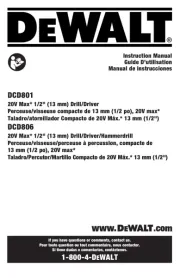
3 Augustus 2025
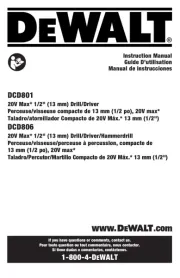
29 Juli 2025

4 Juli 2025
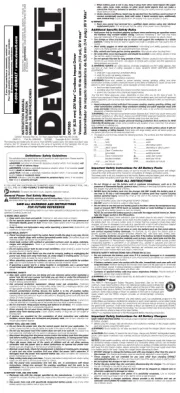
10 Juni 2025

2 Januari 2025

22 November 2024

15 November 2024

2 November 2024

23 September 2024

11 September 2024
Handleiding Boormachine
- Flex
- NEO Tools
- Alpha Tools
- RIDGID
- Huvema
- Cocraft
- Anova
- Carat
- Meister Craft
- Hecht
- Rupes
- Texas
- Ozito
- Rothenberger
- Parkside
Nieuwste handleidingen voor Boormachine
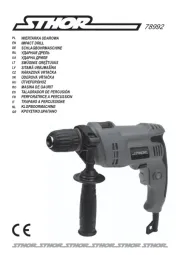
13 September 2025
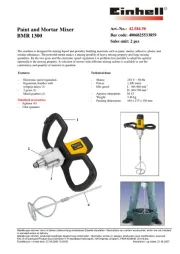
13 September 2025
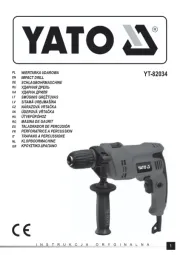
12 September 2025
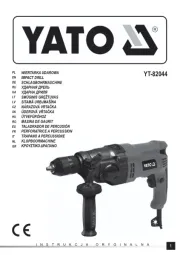
12 September 2025
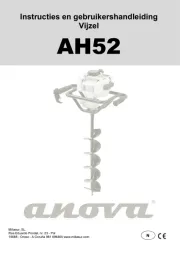
9 September 2025
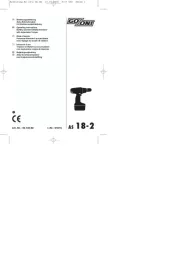
8 September 2025
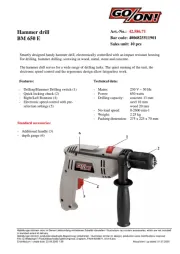
7 September 2025
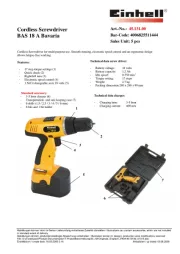
2 September 2025
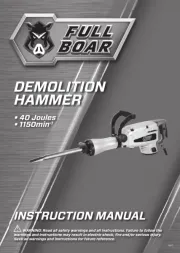
2 September 2025
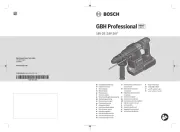
2 September 2025